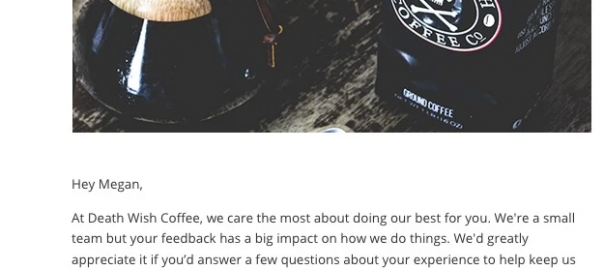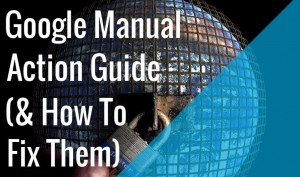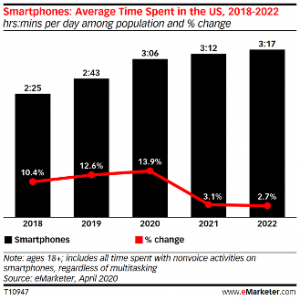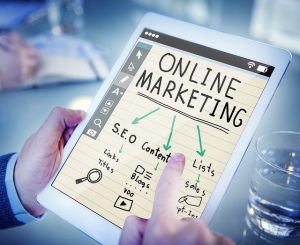With so many retail businesses digitizing, email marketing is more important than ever. As of April 2021, ecommerce sales represent 15% of retail sales in North America, with solid digital marketing campaigns influencing roughly 60% of online retail purchases, according to a report by Absolunet. If you’re reading this, you probably agree, but might be wondering where to begin with your strategy.
A good retail email marketing strategy fosters a relationship with customers who use your product or service, helping your retail business carve out a niche of a massive market. This can be the difference between one-time buyers and loyal customers.
In this article, we’ll go over some ways you can market and grow your business using email, offering some of the best retail email examples available as a guide.
8 retail email examples you can use in your next campaign
It almost seems redundant to speak on the importance of retail email marketing — everyone’s already doing it. If you haven’t fully explored the benefits yet, it may just seem like a marketing tool that’s “nice to have” instead of a necessity.
A good retail email marketing strategy is necessary, though, especially since email has the highest return on investment (ROI) of any form of marketing. Nowadays, retail emails are simple, effective, and easy to create, with many email marketing platforms offering templates for multiple email types. So, dedicating time to developing your email marketing strategy is a wise investment in your business.
From simple tips to deeper tricks, here are eight retail email examples (plus a bonus) that can help guide your next email marketing campaign.
1. The welcome email
Off the bat, the best ecommerce emails make the customer feel like they’re part of a club. It thanks them for their purchase, lets them know what they can expect from you, and can offer incentives for more business.
Your welcome email should include:
- A thank-you message
- Instructions for safelisting you so your messages don’t end up in the spam folder
- An incentive promised in exchange for their email
- An intro to your business
- What the person receiving your emails can expect in the future
- Contact info and social links
Don’t worry about writing a magnum opus here. An effective welcome email will be on the short side — between 50-100 words, according to Customer.io. Your welcome email should also be:
- Brand consistent. Make sure the voice you use to write the welcome email matches your brand’s voice, whether that’s professional, friendly, or irreverent.
- Easy to read. Keep your message short, sweet, and to the point. Use plenty of white space and graphics.
Example: Warby Parker
For our first retail email example, we’ll look at online purveyors of prescription eyewear Warby Parker. The company’s welcome email uses lots of white space, professional photographs, and large text, letting you know the purpose of the message right away.
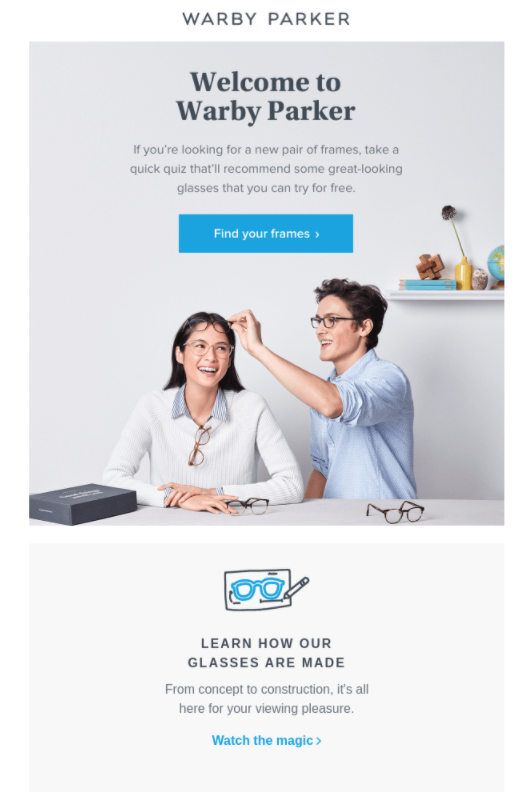
Warby Parker’s welcome email encourages the reader to find the perfect pair of glasses with this engaging call to action. Image source: Really Good Emails
At the top of Warby Parker’s welcome email is a call to action (CTA) link that leads customers to an interactive, frame-fitting quiz. The short message above the button gives new and existing customers an incentive to click by telling them they can try on any frames they find for free.
Several more CTAs are included in the email, all of which have clear links differentiated from the rest of the message by their blue color. Each CTA also has a fun, modern-looking graphic. The language is consistent with the rest of the Warby Parker brand, and both the fonts and overall design of the email are easy on the eyes.
The company also took the time to write accessible code into its email. Meta tags and alt text for screen readers improve accessibility. There’s even code written into the email to let the screen reader program know which language it should use.
2. The promotional email
Retargeted emails with promotions are an easy way to increase sales. Since they’re based on a customer’s past purchases or browsing history, they’re already personalized. The products suggested are ones that the customer will likely want or need, so there’s motivation to buy.
It’s even better if you offer discounts or other incentives in your promotional email. Shoppers are usually more likely to buy an item if they can get a deal.
Good times to send out promotional emails include:
- After someone’s first purchase
- To advertise upcoming holiday season deals, like Black Friday sales
- To advertise a product launch
Basically, anything you want to promote can be used in a promotional email. Simple, right? Just don’t go crazy with them — spamming someone’s inbox is a great way to get them to unsubscribe.
You don’t always have to offer discounts or coupons in these messages, especially if you’re a smaller company. You can find different ways to offer customers value through a promotional email.
Exclusivity is a very popular way a business can use its email list as an incentive. Subscribers can be the first to be notified of sales, for example, or can be given the chance to be first in line to buy a product. You can also send out newsletters as promotional emails, answering common questions and providing information catered to your niche.
You can use promotional emails in your marketing strategy to get in touch with several different audiences, including:
- Customers who haven’t bought anything in a while
- Regular customers
- Shoppers who’ve expressed interest by signing up for email updates, but haven’t yet made a purchase
Promotional emails can be automated, and so can most of the other retail email examples on this list.
Example: The Washington Post
The Washington Post used Earth Day as a reason to send a promotional email to readers who had or were about to let their newspaper subscriptions lapse, offering them a special deal if they renewed.
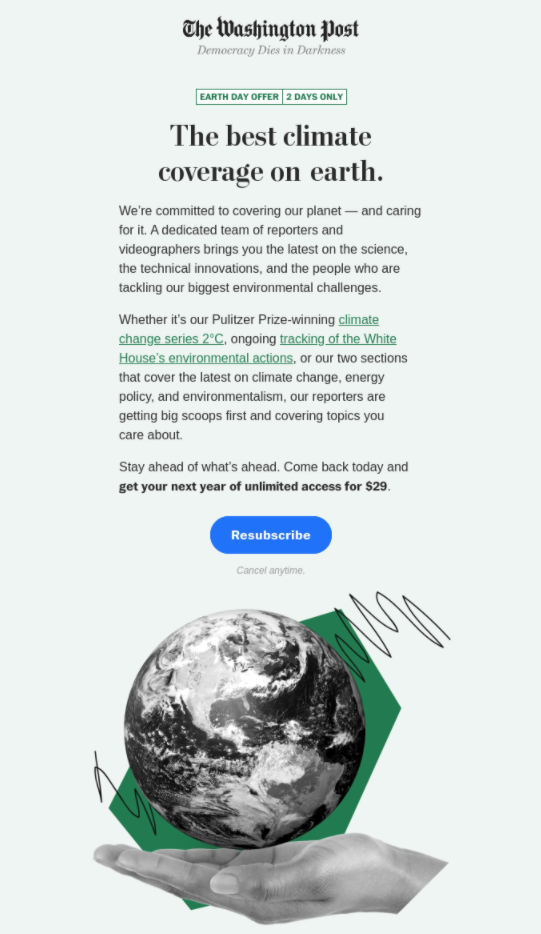
This promo email from the Washington Post pitches the great reporting you get for the price. Image source: Really Good Emails
The newspaper’s promotional email was short and to the point with clear CTAs. It outlined the benefits readers would receive if they resubscribed to the Post, like staying informed on climate change and other topics. It created a little urgency with the “two days only” message, and it closed with a bright blue CTA button that read “resubscribe.”
3. The cart abandonment email
A cart abandonment email tries to nudge customers back to your retail website so they can buy the items that they left inside their online shopping carts, completing their purchases. This type of email is a crucial part of any ecommerce retailer’s toolkit.
Cart abandonment can be a problem if it isn’t managed. According to the Baymard Institute, the average cart abandonment rate among online shoppers is almost 70% — that translates to billions in lost revenue.
There are ways to reduce that figure, though. One of the simplest is by just reminding shoppers they’ve got something waiting for them in their cart, like the example below. They might’ve fully intended to buy it but couldn’t at the moment or just got distracted.
Cart abandonment emails are simple to automate and, according to Digital Commerce 360, they typically bring 60% of shoppers back to buy something within a day of receiving the message. Customers usually plan on coming back when they abandon their cart, so your email might be just the reminder they need.
You can also include recommendations for related products if the item the customer had in their cart wasn’t exactly what they wanted. Since that’s another common reason for cart abandonment, it could nudge the shopper to make a purchase, especially if it fits their needs better than what they found.
Example: Dote
Dote’s cart abandonment email is among the best retail email examples, with a non-pushy message that could convince a customer to return to the online shopping company’s website and complete their purchase.
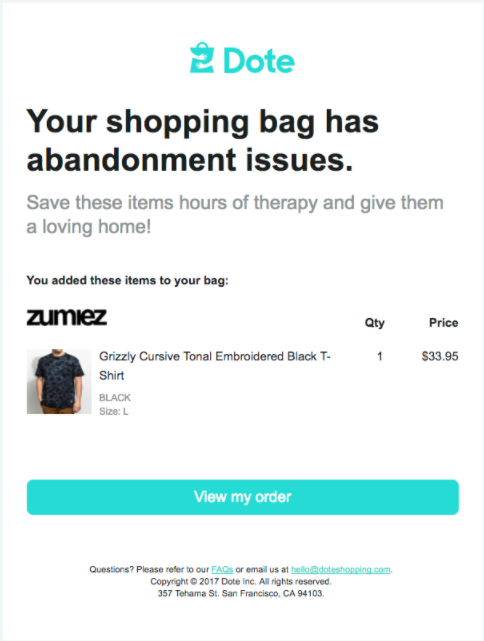
Good copy makes this cart abandonment email a winner. Image source: Really Good Emails
It’s got a short, witty, on-brand message at the top telling the reader that their cart’s got “abandonment issues.” That’s followed by a summary of what was left in their cart, complete with the item’s price. Lastly, there’s a CTA link the customer can follow to view and complete their order.
4. The transactional email
These emails have a lot of utility and a lot of power when used correctly. Any email that gets triggered by a specific user action is transactional, and usually contains important updates for the person receiving it.
Some examples of transactional retail emails include:
- Order confirmations
- Signup confirmations
- Account creations
These emails can build excitement for your product with new buyers and include gentle CTAs for further action. They also create a better buying experience by giving customers information on their orders and letting them track order progress.
As with all of the best ecommerce emails, you’ll want to keep your transactional emails consistent with your brand voice. They should visually and tonally match other customer touchpoints, like your website and social media channels.
That doesn’t mean you need to be long-winded. Tell customers what they want to know up top, whether that be their order and estimated shipping date or a “thank you for subscribing.” After that, you can follow up with a CTA, as long as it’s relevant to the other content of the email. This can include:
- Product suggestions based on what they’ve bought or browsed
- Incentives for sharing your product with their friends
- A link that leads them back to your online store
Since transactional emails are expected and contain important information, they have a fairly high open-rate. They’re a simple way to build a relationship with customers who use your product — customers who shouldn’t be overlooked.
Example: Headspace
Headspace’s confirmation email does everything a transactional email needs to do.
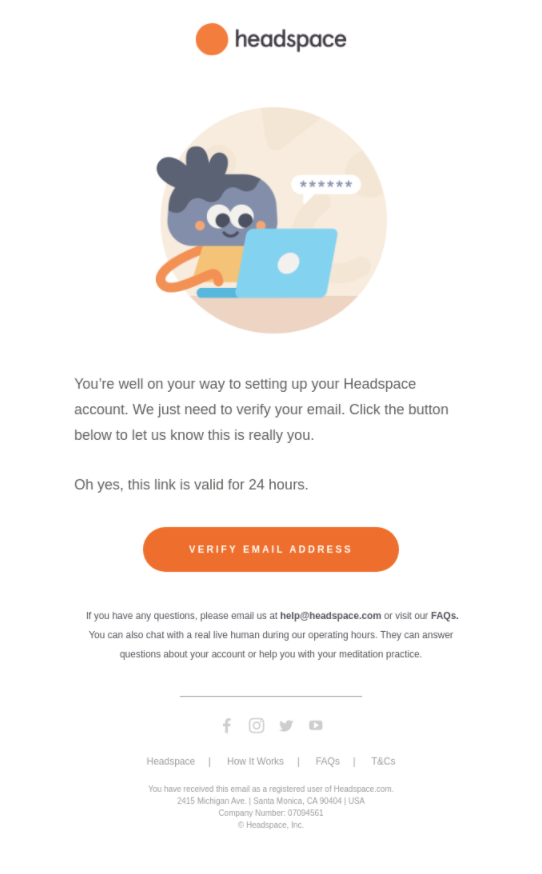
Headspace sends this email to make sure you want to opt-in. Image source: Really Good Emails
In this retail email example, the lettering and graphics are consistent with the meditation app’s branding, the purpose of the email is clearly stated, and the CTA is easy to find. There’s also lots of white space so the body of the email doesn’t feel crowded, and contact info is provided at the bottom.
5. The re-engagement email
It’s much easier to engage with customers who have already found your brand than it is to bring new ones in. Targeted re-engagement emails remind customers who haven’t visited your store in a while that you’re still there and might entice them to come back and see what’s new.
These emails shouldn’t contain a hard sales pitch. Instead, these messages should ask customers if they want to continue hearing from you and give them the option to opt-out if they don’t. This helps you segment your emails so you’re only showing up in inboxes that want you there.
Example: Stocksy
Stock photo and video website Stocksy has a good example of a re-engagement email.
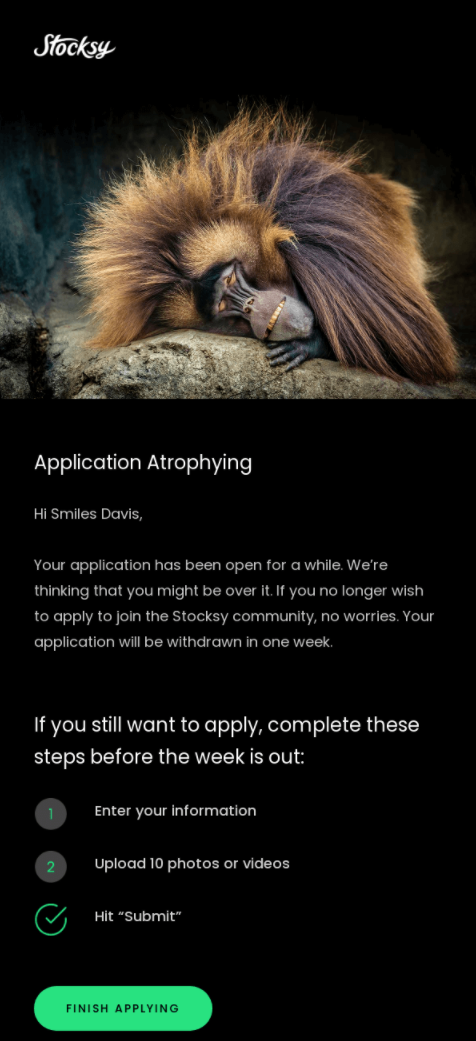
Striking graphics and good copy let the reader know they’ve left something behind. Image source: Really Good Emails
It reminds the recipient that their application to join the platform is waiting for them, gives them steps to complete it, and provides a big green CTA button so they can finish applying. The overall tone is funny and irreverent, which is consistent with the brand.
6. The lead nurturing email
Once you have customers engaged with your brand, it’s important to hold their attention. If they’ve signed up to your email list to get a coupon, for example, then browsed around your website, you could send them an email with an offer on items they’re interested in.
Automated email marketing platforms make it super easy to set up lead nurturing emails to trigger automatically. You can even organize an entire series of emails to be sent out at certain points in the customer journey.
A lead nurturing email can also keep existing customers around longer by offering loyalty incentives. Send them emails with first dibs on the next big sale or coupons to thank them for shopping with your business often.
Example: Judy
This lead nurturing retail email from Judy, a brand that sells emergency preparedness kits, is a great ecommerce email example.
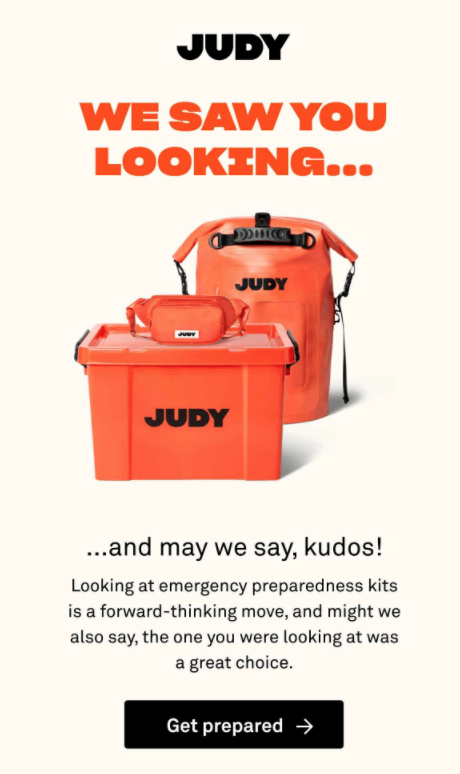
This email from Judy nudges the customer back to that emergency kit they looked at earlier. Image source: Really Good Emails
It shows the customer the item they had looked at while visiting the website and congratulates them for being “forward-thinking.”
A professional photo of the product underscores the company’s brand image, and there’s a clearly marked CTA button if the reader wants to go back to the company’s store.
7. The e-receipt
Electronic email receipts for purchases are gaining massive popularity. For retailers with brick-and-mortar shops, it means they use less paper and ink, making them more environmentally friendly.
Digital receipts are also a perfect way to build your email list. Online stores already require it for every purchase to send a confirmation email, and most shoppers who frequent physical stores will probably agree to get a digital receipt so they can save their payment information.
Of course, it’s important to give customers the option to opt-out of emails at any time and let them know what they’re signing up for when they first give you their information. If they agree to receive emails from you, you can contact them with specials and suggestions, which can help drive revenue.
Digital receipts give you a way to subtly reinforce your brand’s values, which can make someone feel better about shopping with your store.
Example: Allbirds
When environmentally-conscious shoe manufacturer Allbirds sends out a billing email, it includes a message on its commitment to the environment along with a witty note on how the sheep the company uses for its wool products are living the good life.

Allbirds sends customers a thorough e-receipt in an aesthetically pleasing package. Image source: Really Good Emails
8. The check-in email
A type of transactional email, the check-in lets you get feedback directly from your customers. Once a customer receives their order, a check-in email can be sent after they’ve had time to use the product — say, after a couple of weeks.
This retail email example shows customers that you care about their opinion and humanizes your brand. When writing these, focus on customer satisfaction, not immediate sales. The point is to improve their experience and your product.
If enough customers offer valid criticism, it suggests that an improvement needs to be made. If they leave positive reviews, publish them on your website as testimonials. Either way, be sure to thank customers for their feedback.
While you don’t want to sell super hard in these emails, you do have the option of redirecting customers to your site to leave their feedback. Once they’ve submitted it, you could display a couple of suggested products based on what they bought.
Example: Netflix
Netflix’s check-in email is among the best ecommerce email examples mainly because of the simple, straightforward way it asks for customer feedback.
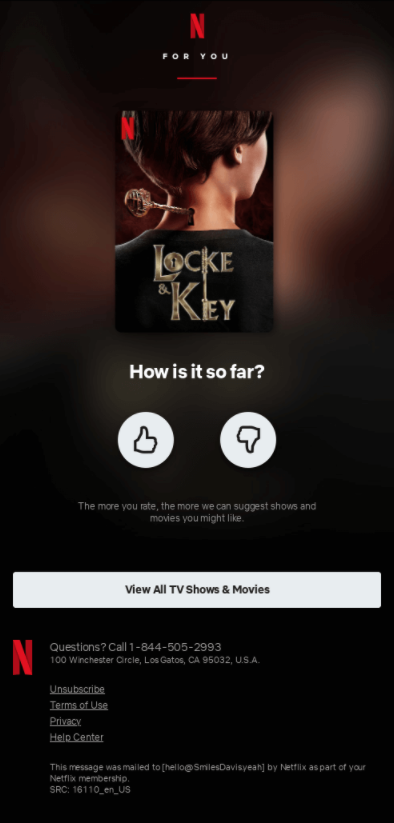
Netflix’s review emails are straight to the point: did you like it or not? Image source: Really Good Emails
The branding is front and center, the graphics are nice, and the color scheme is aesthetically pleasing and easy on the eyes. The purpose of the email is crystal clear: give the show a thumbs up or down to improve the suggestions Netflix gives you.
Bonus example: Death Wish Coffee
In the last of our retail email examples, here’s how Death Wish Coffee uses a check-in email to ask its customers for feedback.
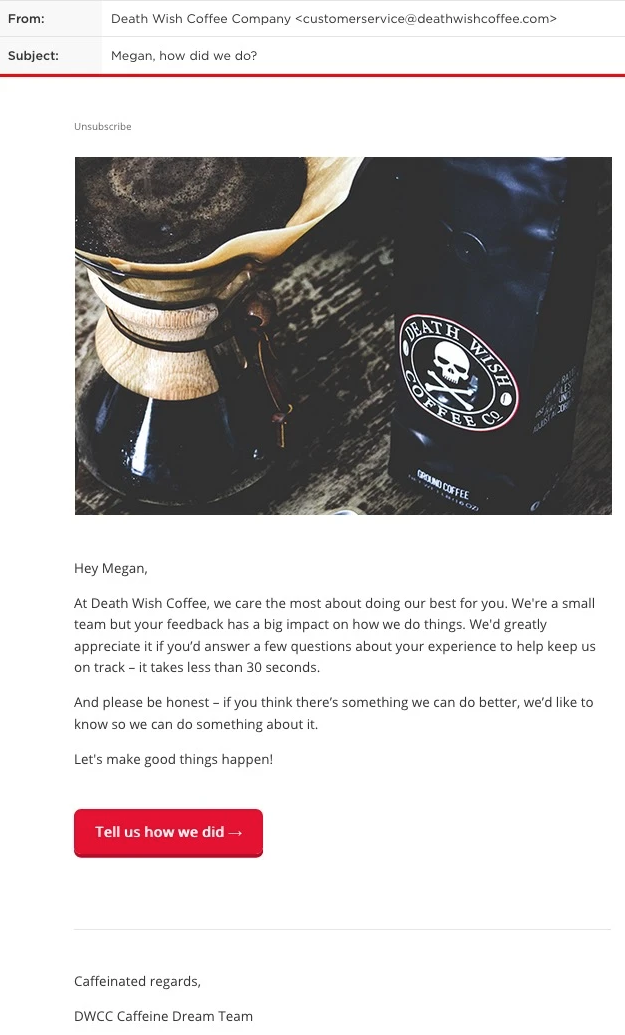
Death Wish checks in with customers to make sure they’re loving the coffee and happy with their experience. Image source: Shopify
The message invites the customer to provide honest feedback on their coffee, lets them know that the survey won’t take up much of their time, and reflects a desire to put out the best products possible. The email closes with a bright red button leading to a survey on the Death Wish Coffee website.
Put it into practice
In today’s online retail space, email marketing is something you can’t afford to neglect. On average, 60% of consumers say they’ve made a purchase because of a marketing email. Put some of these techniques to work and you’ll see some of that money head your way.
Automation and templates make it super easy to set up an email series, automated welcome emails, and cart abandonment emails. Transactional emails can improve the customer’s experience by giving them the information they need quickly as well as provide incentives for future purchases.
You can even A/B test the content of your emails with different audiences, and it’s highly recommended that you do. The more information you collect on a customer’s buying behavior, the more you can be sure they’re only getting the emails they want.
After a customer buys something from you, a quick email survey can collect invaluable feedback. It also lets the customer know you’re listening.
Digital & Social Articles on Business 2 Community
(66)
